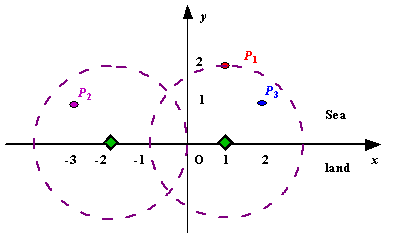| Time Limit: 1000MS | Memory Limit: 10000K | |
| Total Submissions: 43490 | Accepted: 9640 |
Description
We use Cartesian coordinate system, defining the coasting is the x-axis. The sea side is above x-axis, and the land side below. Given the position of each island in the sea, and given the distance of the coverage of the radar installation, your task is to write a program to find the minimal number of radar installations to cover all the islands. Note that the position of an island is represented by its x-y coordinates.

Figure A Sample Input of Radar Installations
Input
The input is terminated by a line containing pair of zeros
Output
Sample Input
3 2 1 2 -3 1 2 1 1 2 0 2 0 0
Sample Output
Case 1: 2 Case 2: 1
思路1:
我们反过来考虑问题,以每个小岛为圆心,雷达的覆盖范围为半径做一个圆,圆和x轴有一个或者两个交点,那么说明至少在两个交点范围内设置一个雷达才能覆盖到这个小岛,我们可以把两个交点标记为起点和终点,那么对于所有的小岛,都有一个起点和一个终点,然后我们先把这些点按起点排序,选定第一个起点和这个点对应的终点,终点设为E,然后向后选择,如果一个点的起点小于E,而且终点也小于E,那么要把E改写为当前这个点的终点;如果当前点的终点大于E,则不用修改。如果当前点的起点大于E,那么说明需要新建一个雷达以覆盖这个点,计数器加以,终点E重新设置为当前这个点的终点。
#include<stdio.h>
#include<utility>
#include<vector>
#include<math.h>
#include<algorithm>
using namespace std;
int main()
{
int num;
// freopen("test.txt", "r", stdin);
vector<pair<double, double> > v;
for(num = 1; ; num ++)
{
int n, m;
bool f = 0;
scanf("%d %d", &n, &m);
if(n == m && m == 0)
break;
int x, y;
pair<double, double> p;
double dis;
while(n--)
{
scanf("%d %d", &x, &y);
if(y > m)
{
f= 1;
}
dis = sqrt(m * m - y * y);
p.first= x - dis;
p.second = x + dis;
v.push_back(p);
}
if(f == 1)
{
printf("Case %d: -1\n", num);
v.clear();
continue;
}
sort(v.begin(), v.end());
vector<pair<double, double> > ::iterator i;
double tail = v[0].second;
int count = 1;
for(i = v.begin() + 1; i != v.end(); i++)
{
double max = tail;
bool flag = 0;
for(; (*i).first <= tail && i != v.end() ; i++)
{
flag = 1;
if((*i).second < tail)
tail = (*i).second;
}
if(i == v.end())
break;
tail = (*i).second;
count ++;
}
printf("Case %d: %d\n", num , count);
v.clear();
}
return 0;
}思路2:今天重新看这个题发现思路1挺乱的,有更简单的思考方式:
以每个小岛为圆心,雷达的覆盖范围为半径做一个圆,圆和x轴有一个或者两个交点,那么说明至少在两个交点范围内设置一个雷达才能覆盖到这个小岛。我们可以把两个交点标记为起点和终点。这样我们就能算出start和end在x轴上的坐标。(这里同思路1)
不同点是:
转换一下题目的描述:
雷达越少越好 == 每个雷达覆盖的小岛数越多越好。
假设我们从左向右安装。
那么选择第一个点的时候第一个end的位置,就是在既能覆盖住第一个点,又能尽量向后覆盖的最后一个位置,这样就能保证覆盖住这个点的同时向后的覆盖面最大。覆盖面更大就更有可能覆盖住后面的点(因为还没有遍历到后面的点,所以后面的点还是未知的),从而实现雷达覆盖的小岛数越多越好这一目标
代码是在思路1的基础上改的,思路1是pair的first是start,second是end,思路二中两个变量换一下(pair自带的排序是先比较第一个)这样就能按end排序了,然后思路就是上面的了:
#include<stdio.h>
#include<utility>
#include<vector>
#include<math.h>
#include<algorithm>
using namespace std;
int main()
{
int num;
vector<pair<double, double> > v;
for(num = 1; ; num ++)
{
int n, m;
bool f = 0;
scanf("%d %d", &n, &m);
if(n == m && m == 0)
break;
int x, y;
pair<double, double> p;
double dis;
while(n--)
{
scanf("%d %d", &x, &y);
if(y > m)
{
f= 1;
}
dis = sqrt(m * m * 1.0 - y * y);
p.second= x - dis;
p.first = x + dis;
v.push_back(p);
}
if(f == 1)
{
printf("Case %d: -1\n", num);
v.clear();
continue;
}
sort(v.begin(), v.end());
vector<pair<double, double> > ::iterator i;
double tail = v[0].first;
int count = 1;
for(i = v.begin() + 1; i != v.end(); i++)
{
if((*i).second > tail)
{
count ++;
tail = (*i).first;
}
}
printf("Case %d: %d\n", num , count);
v.clear();
}
return 0;
}
























 469
469











 被折叠的 条评论
为什么被折叠?
被折叠的 条评论
为什么被折叠?










